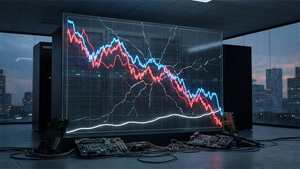
October 21, 2025, finds the financial world abuzz with increasingly urgent warnings from leading analysts and institutions regarding a potential "AI bubble" in the stock market. A growing chorus of experts suggests that the fervent enthusiasm surrounding Artificial Intelligence has pushed valuations of AI-related companies to unsustainable levels, raising the specter of a significant market correction. This sentiment is casting a long shadow over investor confidence, prompting a critical re-evaluation of the sector's long-term stability.
The concerns are not merely speculative; they are rooted in concrete indicators and historical precedents. Major financial bodies, including the Bank of England and the International Monetary Fund (IMF), have explicitly highlighted the "stretched" valuations of equity markets, particularly within the AI domain. The prevailing sentiment is that investors may be underestimating the inherent risks, potentially setting the stage for a sharp downturn if the lofty expectations surrounding AI's transformative power fail to materialize or face unexpected hurdles.
Mounting Concerns and Market Dynamics
The current climate of apprehension is a culmination of several factors, with analysts pointing to a rapid escalation in AI stock valuations over the past year. In October 2025, a Bank of America survey revealed a record 54% of global fund managers now believe AI stocks are in a bubble, identifying this as the paramount "tail risk" globally. This figure marks a significant surge in anxiety among institutional investors, indicating a shift from cautious optimism to outright concern. Jamie Dimon, CEO of JPMorgan Chase (NYSE: JPM), has publicly predicted a "serious market correction" within the next six months to two years, echoing broader fears.
The timeline leading to this moment has been characterized by an unprecedented surge in investment and valuation for companies perceived to be at the forefront of AI innovation. However, the sustainability of this growth is now being questioned. Gartner, a leading research and advisory company, while acknowledging that an "agentic AI market correction" is a natural part of the product lifecycle, cautioned that a "speculative bubble" could still emerge if investments become detached from AI's genuine economic value. Billionaire investor Paul Tudor Jones has drawn stark parallels between the current market sentiment and the dot-com crash of 2001, warning that history may be repeating itself. Even prominent figures like Mark Zuckerberg (NASDAQ: META) of Meta Platforms and Sam Altman of OpenAI have reportedly voiced concerns about the burgeoning AI bubble, underscoring the widespread nature of these anxieties.
The Potential Winners and Losers in an AI Correction
A market correction in the AI sector would undoubtedly create a ripple effect, delineating clear winners and losers across the financial landscape. Companies with robust, diversified business models and substantial, tangible profits from AI applications are more likely to weather a downturn. For instance, tech giants like Microsoft (NASDAQ: MSFT) and Alphabet (NASDAQ: GOOGL) (NASDAQ: GOOG), with their vast ecosystems and established revenue streams, might see a temporary dip but are fundamentally better positioned due to their strategic investments and less speculative valuations compared to some pure-play AI startups. Nvidia (NASDAQ: NVDA), despite its significant gains, possesses a strong market position in AI hardware, and its more reasonable forward price-to-earnings ratio compared to historical tech bubble peaks could offer some resilience.
Conversely, highly speculative AI startups, particularly those with exorbitant valuations but little to no profitability, stand to lose the most. Many such companies have amassed nearly $1 trillion in valuations over the past year despite remaining unprofitable, a scenario reminiscent of the dot-com era. These firms, often reliant on continuous venture capital injections and inflated investor enthusiasm, could face severe funding challenges and even collapse if the market corrects. The Massachusetts Institute of Technology (MIT) recently highlighted a concerning trend: 95% of organizations investing in generative AI are seeing zero return on their investments, a statistic that could fuel investor disappointment and trigger a re-evaluation of these high-flying, yet unproven, entities. Companies engaged in "circular financing," where a complex web of funding relationships artificially inflates valuations, would also be particularly vulnerable as scrutiny intensifies.
Broader Implications and Historical Echoes
The potential AI bubble and subsequent correction carry wider significance, extending beyond the immediate tech sector. This event fits into a broader industry trend of rapid technological advancement leading to periods of intense speculative investment, often followed by a market recalibration. The "Magnificent Seven" tech giants—Nvidia (NASDAQ: NVDA), Microsoft (NASDAQ: MSFT), Apple (NASDAQ: AAPL), Alphabet (NASDAQ: GOOGL), Amazon (NASDAQ: AMZN), Meta Platforms (NASDAQ: META), and Tesla (NASDAQ: TSLA)—now represent an astonishing 20% of the MSCI World Index, a concentration double that observed during the dot-com bubble. This concentration risk means that a significant downturn in these AI-heavyweights could have profound ripple effects across global markets, impacting even companies not directly involved in AI through contagion risk and a general erosion of investor confidence.
Regulatory bodies and policymakers are also keenly observing the situation. The heavy reliance of the U.S. economy on AI investment, with two-thirds of its GDP growth in the first half of 2025 linked to AI, raises questions about the sustainability of this growth without continuous, substantial capital investment. Concerns about "circular financing" and the increasing use of debt, rather than cash flow, to fund AI infrastructure development (as highlighted by Citi Research) could prompt greater regulatory scrutiny on transparency and financial stability within the sector. Historically, this situation draws strong parallels to the dot-com bubble of the late 1990s and early 2000s, where an initial wave of excitement and speculative investment in internet companies eventually led to a severe market crash, serving as a cautionary tale for today's AI-driven market. The Buffett Indicator, comparing total U.S. market value to GDP, stood at a record 217% in October 2025, historically preceding market corrections.
What Comes Next: Navigating the AI Horizon
Looking ahead, the short-term future for AI stocks appears precarious, with a high probability of increased volatility. The upcoming Q3 2025 earnings season is viewed as a critical inflection point. If leading AI companies fail to meet inflated expectations regarding AI spending and monetization, particularly in their forward guidance, it could serve as a powerful catalyst for a market correction. Investors should anticipate a period of heightened scrutiny on actual profitability, return on investment, and sustainable business models rather than mere projections and hype.
In the long term, a market correction, while painful, could ultimately lead to a healthier and more mature AI sector. It would likely weed out unprofitable ventures and force companies to focus on tangible value creation. This could present significant market opportunities for discerning investors to acquire fundamentally strong AI companies at more realistic valuations. Strategic pivots will be crucial for many firms, requiring them to adapt their business models, consolidate, or form stronger partnerships to survive. Potential scenarios range from a sharp, but contained, correction primarily affecting highly speculative stocks to a broader market downturn if contagion spreads. Key challenges include managing investor expectations, demonstrating clear ROI from AI investments, and navigating potential bottlenecks in power, data, or commodity supply chains that could hinder AI's progress.
A Critical Juncture for the AI Market
In summary, the warnings from analysts about an "AI bubble" represent a critical juncture for the stock market. Key takeaways include the widespread belief among fund managers that AI stocks are overvalued, the historical parallels to past speculative bubbles, and the significant concentration risk posed by a few dominant tech companies. The market moving forward is likely to be characterized by increased discernment, with a shift from speculative growth to a demand for proven profitability and sustainable business models.
Investors should watch closely for the results of the Q3 2025 earnings season, any changes in central bank policy, and further developments in AI regulation. Companies that can demonstrate clear, profitable applications of AI, strong cash flows, and prudent financial management will be best positioned to navigate the anticipated turbulence. While the long-term potential of AI remains immense, the immediate future calls for caution and a realistic assessment of current valuations. The coming months will determine whether the AI revolution will continue its ascent or face a necessary, albeit painful, market recalibration.
This content is intended for informational purposes only and is not financial advice






